必修一,unit3教案
人教课标版高中英语必修一 Unit3 Reading for information 教案-新版
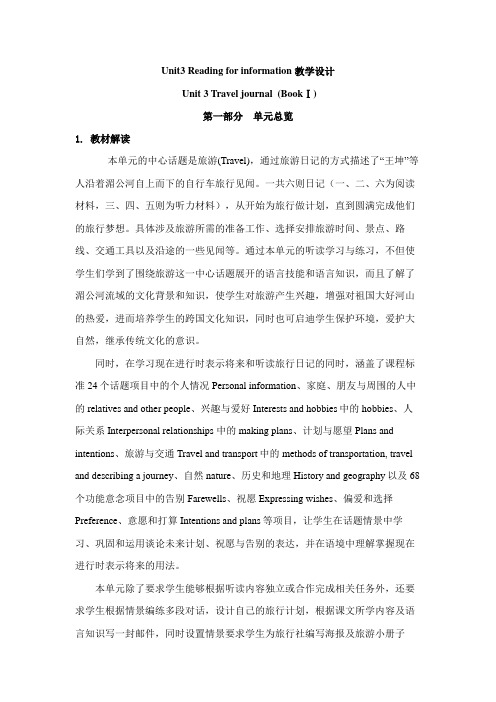
Unit3 Reading for information 教学设计Unit 3 Travel journal (BookⅠ)第一部分单元总览1. 教材解读本单元的中心话题是旅游(Travel),通过旅游日记的方式描述了“王坤”等人沿着湄公河自上而下的自行车旅行见闻。
一共六则日记(一、二、六为阅读材料,三、四、五则为听力材料),从开始为旅行做计划,直到圆满完成他们的旅行梦想。
具体涉及旅游所需的准备工作、选择安排旅游时间、景点、路线、交通工具以及沿途的一些见闻等。
通过本单元的听读学习与练习,不但使学生们学到了围绕旅游这一中心话题展开的语言技能和语言知识,而且了解了湄公河流域的文化背景和知识,使学生对旅游产生兴趣,增强对祖国大好河山的热爱,进而培养学生的跨国文化知识,同时也可启迪学生保护环境,爱护大自然,继承传统文化的意识。
同时,在学习现在进行时表示将来和听读旅行日记的同时,涵盖了课程标准24个话题项目中的个人情况Personal information、家庭、朋友与周围的人中的relatives and other people、兴趣与爱好Interests and hobbies中的hobbies、人际关系Interpersonal relationships 中的making plans、计划与愿望Plans and intentions、旅游与交通Travel and transport中的methods of transportation, travel and describing a journey、自然nature、历史和地理History and geography以及68个功能意念项目中的告别Farewells、祝愿Expressing wishes、偏爱和选择Preference、意愿和打算Intentions and plans等项目,让学生在话题情景中学习、巩固和运用谈论未来计划、祝愿与告别的表达,并在语境中理解掌握现在进行时表示将来的用法。
必修一unit3教案
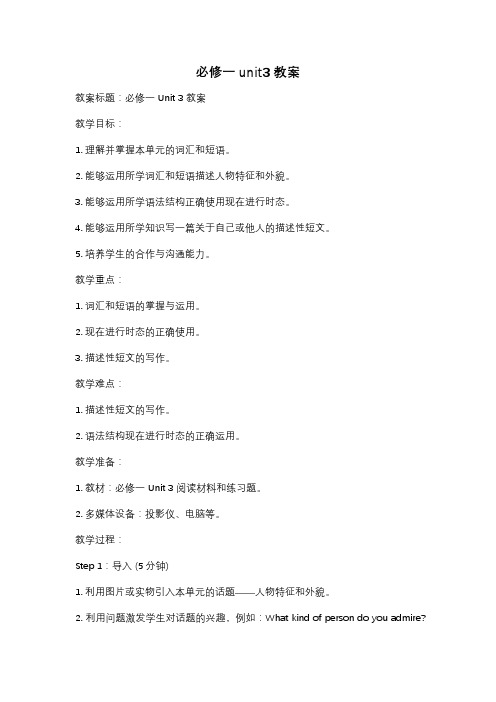
必修一unit3教案教案标题:必修一 Unit 3 教案教学目标:1. 理解并掌握本单元的词汇和短语。
2. 能够运用所学词汇和短语描述人物特征和外貌。
3. 能够运用所学语法结构正确使用现在进行时态。
4. 能够运用所学知识写一篇关于自己或他人的描述性短文。
5. 培养学生的合作与沟通能力。
教学重点:1. 词汇和短语的掌握与运用。
2. 现在进行时态的正确使用。
3. 描述性短文的写作。
教学难点:1. 描述性短文的写作。
2. 语法结构现在进行时态的正确运用。
教学准备:1. 教材:必修一 Unit 3 阅读材料和练习题。
2. 多媒体设备:投影仪、电脑等。
教学过程:Step 1:导入 (5分钟)1. 利用图片或实物引入本单元的话题——人物特征和外貌。
2. 利用问题激发学生对话题的兴趣,例如:What kind of person do you admire?Why?Step 2:词汇和短语学习 (15分钟)1. 呈现并教授本单元的词汇和短语,例如:appearance, personality, confident, determined, etc.2. 运用图片和例句帮助学生理解和记忆词汇和短语。
3. 进行词汇和短语的练习,例如:单词拼写、填空等。
Step 3:语法学习 (20分钟)1. 介绍现在进行时态的用法和构成。
2. 利用图片和例句帮助学生理解和记忆现在进行时态的用法。
3. 进行现在进行时态的练习,例如:选择填空、改错等。
Step 4:阅读理解 (15分钟)1. 学生阅读本单元的阅读材料,并回答相关问题。
2. 学生之间进行小组讨论,分享自己的理解和答案。
3. 教师进行解答和讲解,帮助学生更好地理解和掌握阅读材料。
Step 5:写作练习 (20分钟)1. 学生根据所学词汇、短语和语法结构,写一篇关于自己或他人的描述性短文。
2. 学生之间进行互相交流和修改,提供反馈和建议。
3. 部分学生展示自己的作文,进行班级评价和讨论。
人教版高中英语必修一unit 3 sports and fitness整单元教学设计教案

Teaching and Learning Design人教社2019年版高中英语新教材Book1Unit 3 Sports and Fitness单元语篇教学设计单元语篇教学分析与整体设计单元主题名称: 运动与健康单元主题语境:人与自我之运动与健康单元主题内容:本单元以运动和健康为主题,从不同方面说明运动除了竞赛的目的,更多的还是为了身心的健康。
年轻人参加运动不仅能强身健体,还可以锻炼意志和耐力,学会与人合作,学会承受压力和失败,学会挑战自己的极限。
单元主题育人功能:本单元旨在帮助学生了解世界各地的特色体育项目、著名运动员和大型体育赛事。
形成正确的健身意识和习惯。
理解体育精神和公平竞争的深刻含义。
单元板块与课程内容要素分析:课程内容要素板块名称:Opening page语篇主题/话题语篇1 All sports for all people语篇类型多模态语言知识名人名言文化知识名人名言语言技能看、说——体育明星和赛事、喜欢的体育项目及其好处学习策略明确单元学习目标,周密计划单元学习课程内容要素板块名称:Listening and Speaking (+Pronunciation)语篇主题/话题语篇2 邀请朋友参加体育运动(Invite a friend to a sports event)语篇类型口语对话/听说语篇语言知识 1. 体育项目词汇;2. 邀请别人以及答复邀请的语言表达方式;3. 掌握附加疑问句升调和降调的基本知识。
文化知识各类运动项目(经典的、新奇有趣的、室内外、南北方不同的运动方式)语言技能听、说——提出邀请和答复邀请学习策略听取对话的主旨大意Listen for main idea课程内容要素板块名称:Reading and thinking语篇主题/话题语篇3 选择你最喜欢的运动员(Choose your favorite athlete)语篇类型杂志文章之人物传记语言知识 1.与体育运动相关的词汇;2. 就运动员的表现和体育精神表达同意或不同意的观点;3.阅读杂志文章,提取主要信息和观点,形成个人见解4.杂志文章语篇文本结构。
2023年新人教版高中英语必修一《Unit3SportsandFitness》单元教案(附导学案)

《Unit 3 Sports and Fitness》单元教案Unit 3 Sports and FitnessPeriod 1 Listening and Speaking & Listening and Talking【教材分析】In this period, the theme is “sports and health”. Students will have a general understanding of how to invite a friend to a sports event and voice one’s own opinions about sportsmanship by listening and ultimately can form a healthy lifestyle and good attitudes towards sports.Listening and Speaking introduces the topic of sports events with posters advertising them, along with related vocabulary and grammar, and is a warm-up for the activities which follows.Listening and Talking introduces idea of sportsmanship by listening to a conversation, matching speakers’ opinions and giving and discussing one’s own opinions.【教学目标与核心素养】1.Instruct students to get main facts by listening and motivate them to talk about the topics about how to invite a friend to a sports event ,voice one’s own opinions about sportsmanship by listening.2.Develop students’sense of cooperative learning and individual thinking capability.3.Develop students’different listening skills to solve different listening comprehensive problems.【教学重难点】1.Teach students how to focus on key words, not on single words or grammar.2.Prompt Ss to talk about the related topics, such as how to invite a friend to a sports event and voice one’s own opinions about sportsmanship.【教学过程】Part 1: Listening and SpeakingLead inThe teacher is advised to talk with their students about sports events.Boys and girls, look at the posters on p36, what sports events do you like to watch? Which sports would you like to try? After their small talk, the teacher can move on by finishing the following listening task:Play conversation 1 which is about Shen Qi’s main purpose for talking to Amy and after finishing listening for the first time, the students need to solve the following tasks.1.Purpose2.Listen to conversation 1 again and write down the words that the speaker stresses:Listening tip:Listen for main ideas.Try to catch the main ideas instead of trying to remember and translate each word you hear.After finishing the task above, the teacher is expected to play conversation 2 which is about Adam’s inviting Julie to a sports event and after finishing listening, the students need to solve the following task.Listen to Conversation 2. Then answer the following questions:1.When will the event happen?The event will happen2.What”s a “Blue Paint“ run?A “Blue Paint“ run is a fun run that3.Why is it called a “Blue Paint“ run?Because people can buy water ballons flled with and the runners.4.If 200 people take part in the run and 400 balloons are sold, how much money will they collect?Finally, after finishing the task above, the teacher is expected to instruct students to work in groups to finish the following project:Speaking ProjectWhat event or activity would you like to invite your friend to? Make a conversation with a partner.Ski Race: Zhangjiakou, a beautiful city in northern China, will host the Youth Ski Race in December.Track Meet: a great event for track –and –field lovers on 26 October.Gym Class: come and work out at a gym! You can make it.Part 2: Listening and Talking:The teacher is advised to talk with their new students about the related topic:Boys and girls , what do you think of sportsmanship? Let’s listen and find out: Play the listening and match each opinion with the right speaker. Who do you agree with? Why?Cao Jing Lily MaxA.An athlete should do his/her best to win.B.The girl should stop and help the other girl. Good sportsmanship is more important than wining!C.An athlete should think about honor and his/her fans if he/she is competing for his/her country.Listen again and circle the expressions that you hear in the conversation.agreeingI agree.So do I. Exactly!All right Good idea. Yes, I think so. disagreeingI”m sorry, but I disagree/don”t agree. I don”t think so. That”s not right.That doesn”t make any sense! That”s not how I see it.I see what you mean, but …Me too.Sure./Certainly./Of course. You”re right/correct.I guess so.Talking projectWork in groups. Choose one of the situations below and make a conversation:●A soccer player should not pretend to fall down even if it helps his/her team.●In school teams, everyone should get a chance to play, not only the best players.●It is wrong to pay people millions of yuan to play sports.●Athletes should play only for their own country.EXAMPLEA: I agree with the idea that a soccer player should never pretend to fall down even if it helps his or her team. You should never cheat.B: Exactly! It”s important to do the right thing.C: Well, don”t think so. Many players do it, and they think it helps their team to win. A: That doesn”t make any sense!B: I see what you mean, but the audience wants fair play.Unit 3 Sports and Fitness-Listening and Speaking & Listening and Talking【教材分析】This lesson focuses on the discourse analysis of its organization and features. Through the questions, the students are guided to sort out why Lang Ping and Jordan are masters and what role models they set. On this basis, the students are allowed to use the language they have learned to talk about the sports stars in their minds.【教学目标与核心素养】1.Read quickly to get basic information about Lang Ping and Jordan; read deeply to understand why they can be called sports legends.2.Understand the meaning of some languages in the context of the text through question guidance, such as “time seems to stand still, graceful“ and so on.3.Read and clarify the context of each part of the text, learning how to talk a write sports legends.4.Through comparativeanalysis,w e can form the criterif aor judgingthelegendary figures and learn to choose the legendary sports stars we like.【教学重难点】1.Get basic information about Lang Ping and Jordan; read deeply2.Understand why they can be called sports legends.3.Understand the meaning of some languages in the context of the text, such as “time seems to stand still, graceful“ and so on.【教学过程】Step 1 Leading-in1.Have the Ss ask and answer in pairs.Q1: Who are your favorite sports player?Q2: Do you like him/her? Why?2.Then ask the Ss to talk about Lang Ping and Michael Jordan, and have several Ss to share their ideas.Q1: What do you know about Lang Ping and Michael Jordan?Q2: What else do you want to know about them?Step 2Understanding the title and the lead paragraph.Have the Ss think about the title and answer the following questions.Q1: Why do you think the author chooses to write these two sports stars?Q2: What does “living legend” mean?Q3: What are the standards or requirements to be chosen as a living legend of sports star?Then discussthe questionsabove in groups,then have someone to sharetheir ideas.Step 3 Getting detailed information about Lang Ping1.Read to answer the following questions.Living legends Jordan Masters?Good examples?Q1: Is Lang Ping a master in her area? How do you know that?Q2: What good examples does Lang Ping set for others?2.Read again and Focus on the story about Lang Ping. Then try to retell the story of Lang Ping.Step 4 Exploring detailed information about Michael Jordan1.Read the paragraph of Michael Jordan and complete the following table.We have got to know why Lang Ping is a living legend. Now read and find out why Michael Jordan is a living legend on your own by completing the following table.2.Sort out detailed information about Michael Jordan.(1)Understand the transitional sentence.Q: Which part is about Michael Jordan as a master? Which part is about the example he set?(2)Have the Ss Focus on why Michael Jordan is a master and what good examples Michael Jordan set when they’re reading. And think about these questions as below:Q1: How does the author describe his impressive skills?Q2: How do you understand “time seemed to stand still”?Q3: What does “graceful” mean?Q4. Which sentence do you think best describes his mental strength?Q5. Which words is important in the sentence in describing his mental strength? Why?Q6: How do you understand “unique”?Q7: What can we learn from Michael Jordan?Step 5 Discussing and recommendingRecommend their own living legends of sports.Work in groups to choose your own living legend of sports and give the reasons of your choice.Step 6 HomeworkReview the stories of Lang Ping and Michael Jordan, and try to retell them.Unit 3 Sports and FitnessPeriod 3 Discovering Useful Structures—tag questions【教材分析】This teaching period mainly deals with the grammar: tag questions.This period carries a considerable significance to the cultivation of students’spoken English. The teacher is expected to enable students to master this period thoroughly and consolidate the knowledge by doing some exercise of good quality. 【教学目标与核心素养】1.Get students to have a good understanding of the basic usages of tag questions.2.Enable students to use the basic phrases structures flexibly.3.Develop students’ speaking and cooperating abilities.4.Strengthen students’ great interest in grammar learning.【教学重难点】1.How to enable students to have a good understanding of the basic usages of tag questions.2.How to enable students to use the basic usages of tag questions flexibly.【教学过程】Step1: 语法自主探究一、根本组成方法1. 确定式陈述You often play badminton, don’t you?你常常打羽毛球,是吗?局部+否认附加You are going to the gym with me, aren’t you?疑问局部〔前肯你要和我一起去健身房,是吗?她以前去过上海,是后否〕She’s been to shanghai before, hasn’t she?吗?2.否认式陈述It isn”t a beautiful flower, is it?那不是秀丽的花,是吗?局部+确定附加You didn”t go skating yesterday, did you? 你昨天没去滑冰,是疑问局部〔前否吗?后肯〕They can’t finish it by Friday, can they?他们不能在星期五之前完成,是吗?3.含有否认词〔1 〕当陈述句中含有He hardly goes to school by car, 的附加疑问句seldom, hardly, never, does he?rarely, little, few, none, 他几乎不开车去上学,是吗?neither ,no, not, nowhere, You have never been to Paris, havenothing no one, nobody 等you?否认意义的词时,后面的你从没去过巴黎,是吗?附加疑问句则为确定形They seldom come late, do they?式。
人教版 高中英语必修一 Unit 3 教案

课题
UNIT 3 Sports and Fitness
Period4Listening and Talking
学科
英语
班级
授课教师
教学目标
By the end of this section, students will be able to:
1.get different people’s opinions on sportsmanship through extensive listening;
教学
重点
1.指导学生通过泛听捕捉不同人物的观点。
2.指导学生积累表达同意和不同意某观点的日常用语。
教学难点
1.指导学生在具体的语境中,学会使用表达同意和不同意某观点的日常用语。
2.指导学生逐步理解体育竞技的内涵以及真正的体育精神,学会以批判的眼光看待现实问题,并作出理性思考与判断。
教
学
内
容
与
过
程
Step 1 Lead-in
Step 3 While-listening
Task 1 Extensive listening己的预测是否正确。
Task 2 Intensive listening
让学生听第二遍录音,完成课本P41活动2,圈出所听到的关于同意和不同意的表达。
2.identify and circle some expressions about agreement and disagreement that they hear in the conversation;
3.discuss and debate specific opinions about sportsmanship using expressions of agreement and disagreement;
英语人教版高中必修一(新课标)教案Unit 3 Reading and Thinking 教案

Unit 3 Sports and FitnessPeriod 2 Reading and Thinking教材分析本课时的活动主题是“选择你最喜欢的运动员”(Choose your favourite athlete)。
该文本属于杂志文章,有明显的标题特征、结构特征和语言特征。
文章创设的情境,即某杂志社请读者来信选举自己心目中的“体育界的活传奇”( Living Legends of Sports),在此基础上,使学生能够使用所学知识来评选自己心中的体育传奇明星,并且能够表达自己对“体育精神”的理解,目的是培养学生理性思考和客观评判的思维品质。
另外还应该从这些传奇人物身上领会和感悟做人和做事的道理。
教学目标1. 快速阅读获取有关郎平和乔丹的基本信息;深入阅读了解他们被称为体育传奇的原因。
2. 通过提问引导学生理解某些语言在文本中的含义,如“time seems to stand still, graceful…”等等。
3. 阅读并理解课文各部分的上下文,学习如何说和写sports legend。
4. 通过对比分析,形成判断传奇人物的标准,学会选择自己喜欢的传奇体育明星。
教学重难点【教学重点】1.深入了解郎平和乔丹的基本情况。
2.理解他们被称为sports legends的原因。
【教学难点】理解某些语言在文本中的含义,例如“time seems to stand still, graceful…”等等。
教学过程Step 1 Warming-upLook at some famous sports stars’ pictures and have a discussion about them.设计意图:引导学生欣赏著名运动明星的图片及讨论知名运动员及运动的功能,引出本单元话题,并对本课将要学习的两位运动员郎平和乔丹做好铺垫。
Step 2 Pre-reading1.Work on Activity 1. Look at the titles and pictures, and predict what the text is about.2.Brainstorm: What aspects will be involved when we talk about “living legends of sports”?设计意图:通过浏览图片、标题、小标题以及板式预测文本内容。
高一英语教案(说课稿):人教版必修一Unit3 Journey down the Mekong
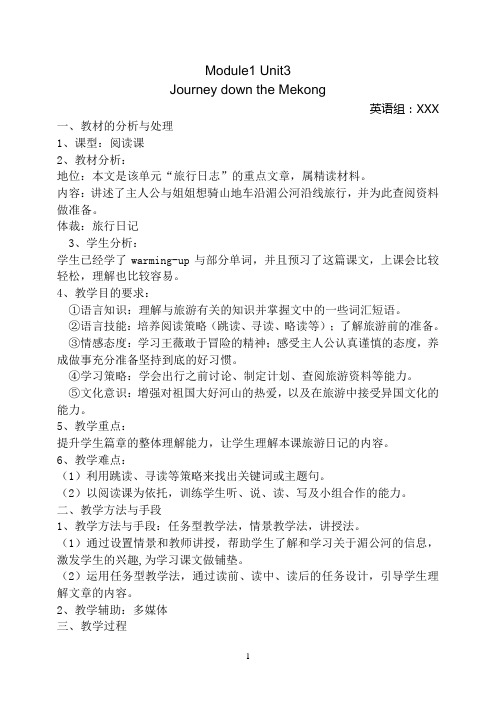
Module1 Unit3Journey down the Mekong英语组:XXX一、教材的分析与处理1、课型:阅读课2、教材分析:地位:本文是该单元“旅行日志”的重点文章,属精读材料。
内容:讲述了主人公与姐姐想骑山地车沿湄公河沿线旅行,并为此查阅资料做准备。
体裁:旅行日记3、学生分析:学生已经学了warming-up与部分单词,并且预习了这篇课文,上课会比较轻松,理解也比较容易。
4、教学目的要求:①语言知识:理解与旅游有关的知识并掌握文中的一些词汇短语。
②语言技能:培养阅读策略(跳读、寻读、略读等);了解旅游前的准备。
③情感态度:学习王薇敢于冒险的精神;感受主人公认真谨慎的态度,养成做事充分准备坚持到底的好习惯。
④学习策略:学会出行之前讨论、制定计划、查阅旅游资料等能力。
⑤文化意识:增强对祖国大好河山的热爱,以及在旅游中接受异国文化的能力。
5、教学重点:提升学生篇章的整体理解能力,让学生理解本课旅游日记的内容。
6、教学难点:(1)利用跳读、寻读等策略来找出关键词或主题句。
(2)以阅读课为依托,训练学生听、说、读、写及小组合作的能力。
二、教学方法与手段1、教学方法与手段:任务型教学法,情景教学法,讲授法。
(1)通过设置情景和教师讲授,帮助学生了解和学习关于湄公河的信息,激发学生的兴趣,为学习课文做铺垫。
(2)运用任务型教学法,通过读前、读中、读后的任务设计,引导学生理解文章的内容。
2、教学辅助:多媒体三、教学过程Step1: Lead inAsk some students to present their dialogue.(The homework of last class)【设计说明】采用对话形式导入,营造出宽松的学习气氛,为学生全面的课堂参与作了铺垫。
Step2: Pre-readingShow students some pictures and maps to know more about the Mekong river, its two names and the route it flows out of China.1. Names: Lancang River and Mekong River2. Route: China-Myanmar-Laos-Thailand-Cambodia-Vietnam-South China sea 【设计说明】利用图片来了解湄公河,为课文第三段做铺垫,同时,激发了学生的兴趣和好奇心。
英语必修一unit3教案

英语必修一unit3教案教案标题:英语必修一Unit 3: Travel journal教学目标:1. 通过本单元的学习,学生将能够掌握有关旅行和文化交流的词汇和表达方式。
2. 培养学生的听、说、读、写的综合能力,提高他们的语言运用能力。
3. 培养学生的跨文化交流意识和能力,增强他们对不同文化的理解和尊重。
教学重点:1. 词汇和短语:travel, journey, destination, explore, cultural exchange, customs, traditions, etc.2. 句型结构:What's your destination? How do you feel about...? Have you ever been to...?教学难点:1. 学生能够熟练运用所学词汇和句型进行口头和书面表达。
2. 培养学生的跨文化交流意识和能力,使他们能够更好地理解和尊重不同文化。
教学准备:1. 教材:英语必修一教材Unit 3相关课文和练习题。
2. 多媒体设备:投影仪、电脑、音频设备等。
教学过程:Step 1: 导入新课1. 利用多媒体设备播放一段关于旅行的视频,激发学生对旅行的兴趣。
2. 引导学生谈论自己最喜欢的旅行目的地,并分享他们的旅行经历。
Step 2: 课文阅读1. 学生阅读课文,并回答相关问题,检查他们对课文内容的理解程度。
2. 分组讨论:学生根据课文内容,讨论自己对旅行和文化交流的看法,并展示他们的观点。
Step 3: 词汇与表达1. 教师呈现本单元相关词汇和短语,并进行发音和词义解释。
2. 学生进行词汇和短语的搭配练习,通过口头和书面表达巩固所学内容。
Step 4: 句型训练1. 教师呈现本单元相关句型,并进行语法解释和例句演示。
2. 学生进行句型练习,通过角色扮演和对话练习,提高他们的口语表达能力。
Step 5: 语言运用1. 学生完成课本中相关练习题,巩固所学内容。
人教版英语必修一Unit 3(Reading)教学教案
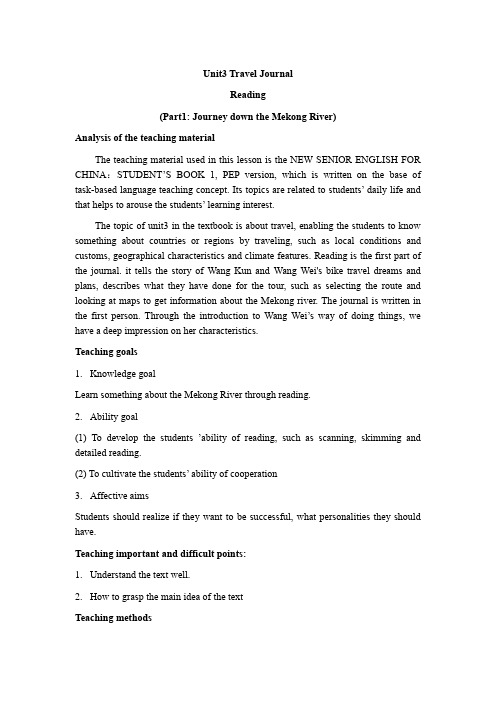
Unit3 Travel JournalReading(Part1: Journey down the Mekong River)Analysis of the teaching materialThe teaching material used in this lesson is the NEW SENIOR ENGLISH FOR CHINA:STUDENT’S BOOK 1, PEP version, which is written on the base of task-based language teaching concept. Its topics are related to students’ daily life and that helps to arouse the students’ learning interest.The topic of unit3 in the textbook is about travel, enabling the students to know something about countries or regions by traveling, such as local conditions and customs, geographical characteristics and climate features. Reading is the first part of the journal. it tells the story of Wang Kun and Wang Wei's bike travel dreams and plans, describes what they have done for the tour, such as selecting the route and looking at maps to get information about the Mekong river. The journal is written in the first person. Through the introduction to Wang Wei’s way of doing things, we have a deep impression on her characteristics.Teaching goals1.Knowledge goalLearn something about the Mekong River through reading.2.Ability goal(1) To develop the students ’ability of reading, such as scanning, skimming and detailed reading.(2) To cultivate the students’ ability of cooperation3.Affective aimsStudents should realize if they want to be successful, what personalities they should have.Teaching important and difficult points:1.Understand the text well.2.How to grasp the main idea of the textTeaching methodsTask-based language teachingTeaching aids: a computer & a projectorTeaching proceduresStep ⅠLead In(1minute)T: Q1: Have you visited any river?Q2: How many great rivers do you know?Q3: If you can travel down only one of them, which one would you choose? Why?Show pictures and maps of some famous rivers in China, students tell their names. (The Yellow River, the Changjiang River, the Pearl River and the Mekong River)Step ⅡPre-reading(2 minutes)T: Have you visited the Mekong River? If no, let’s learn something about it.1. Show a map of the Mekong River and the brief introduction of it. Ask them:Can you list the countries that the Mekong River flows through?Step ⅢReading(26minutes)In this step, get the students to read the text and finish some tasks.Fast-reading:Task1: Scan the text quickly, and then answer some questions (10minutes):Q1. What is the main idea of each paragraph?Q2.where is the source of the Mekong River and which sea does it enter?Evaluation way: oral evaluation made by students.Detailed-readingTask2:The whole read paragraph 1 loudly and find out the answer of the following questions: (4minutes)Q1、What is Wang Kun and Wang Wei’s idea of a good trip?Q2、Who are Dao Wei and Yu Hang?Q3、Who plans the trip to the Mekong?Evaluation way: oral evaluation made by teacher.Task3:Listen to the tape of paragraph 2 carefully, and then finish the True orFalse questions: (4minutes)1. Wang Wei thinks that her way is the proper way.2. Wang Wei is a stubborn and careful girl.3. The journey is difficult because it begins at an altitude of more than 5,000 meters, where it is hard to breathe and very cold.Evaluation way: oral evaluation made by teacher.Task4:Role-Play. Suppose that one student is guide, the others are foreigners going to travel along the Mekong River, please the guide to introduce to the foreigners about what they can see during the journey. Read paragraph 3 carefully first. (4minutes).Evaluation way: oral evaluation made by students.Task5: Consolidation: retell the passage and fill in the blanks (4minutes)Wang Kun and Wang Wei had ________ (dream) of taking a bike trip for a long time. After they graduated _____ college, they were ___________ (determine) to cycle along the Mekong River. In order to do the trip __________ (proper), they went to the library and found a large atlas with good _____(map) in it. After a careful study to the maps, they found the source of the river and made up ______ mind to begin their journey ____ an altitude of 5,000 meters. During their journey, they could enjoy the ________(beauty) scenery of glaciers, deep valleys, waterfalls and plains.Evaluation way: oral evaluation made by teacher.Step IV Post-reading (10minutes)Task 6:Make comparison (5minutes)An attitude is what a person thinks about something. Make lists of Wang Wei’s and Wang Kun’s similar and different attitudes about the trip.Evaluation way: oral evaluation made by groups.Task 7: Debate (5minutes)Which character do you like, Wang Kun or Wa ng Wei? Why?Evaluation way: oral evaluation made by teacher.Step V Homework (1minute)1. Read the text again.2. Write a passage about your own travel experience.。
高一英语必修一unit3教案
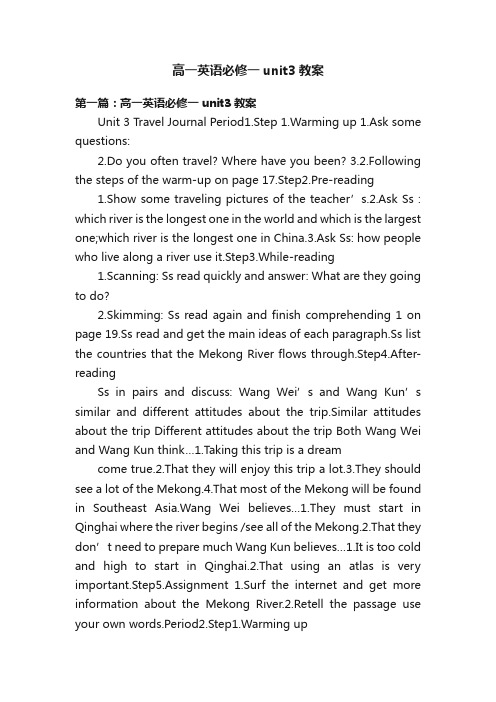
高一英语必修一unit3教案第一篇:高一英语必修一unit3教案Unit 3 Travel Journal Period1.Step 1.Warming up 1.Ask some questions:2.Do you often travel? Where have you been?3.2.Following the steps of the warm-up on page 17.Step2.Pre-reading1.Show some traveling pictures of the teacher’s.2.Ask Ss : which river is the longest one in the world and which is the largest one;which river is the longest one in China.3.Ask Ss: how people who live along a river use it.Step3.While-reading1.Scanning: Ss read quickly and answer: What are they going to do?2.Skimming: Ss read again and finish comprehending 1 on page 19.Ss read and get the main ideas of each paragraph.Ss list the countries that the Mekong River flows through.Step4.After-readingSs in pairs and discuss: Wang Wei’s and Wang Kun’s similar and different attitudes about the trip.Similar attitudes about the trip Different attitudes about the trip Both Wang Wei and Wang Kun think…1.Taking this trip is a dreamcome true.2.That they will enjoy this trip a lot.3.They should see a lot of the Mekong.4.That most of the Mekong will be found in Southeast Asia.Wang Wei believes…1.They must start in Qinghai where the river begins /see all of the Mekong.2.That they don’t need to prepare much Wang Kun believes…1.It is too cold and high to start in Qinghai.2.That using an atlas is very important.Step5.Assignment 1.Surf the internet and get more information about the Mekong River.2.Retell the passage use your own words.Period2.Step1.Warming upAsk some Ss to retell the passage that they have learnt last period.Step2.Learning about the languageTeacher explains some language points in the text on page 18.1.Persuade sb.into /out of sth.: cause sb.(not)to do sth.by arguing or reasoning with him 说服或劝说某人(不)做某事He is easily persuaded.Wang Kun couldn’t persuade his sister to change her mind.persuade sb.(that clause): cause sb.to believe sth.;convince sb.使某人信服How can I persuade you that I am telling the truth?2.insist(v.): demand(sth)forcefully, not accepting a refusal 坚持或坚决要求;eg.Since he insisted, I had to stay.insist on sth/doing sth: require or demand;refuse to accept an alternative 一定要(某事物),坚决主张She insists on getting up early and playing her radio loud.3.care about: be worried, concerned or interested 忧虑,关心,惦念don’t you care about anybody? I don’t care about what happens to him.care for /to do: be willing or agree to do sth.;wish or like to do sth.Would you care a drink? Would you care to go for a walk? care for sb.1).Like or love sb.He cares for her deeply.2).Look after sb;take care of sb;be responsible for sb Who will care for your child if you are out?4.Once she has made up her mind, nothing can change it.她一旦下了决心,什么也不能使她改变。
人教版高中英语必修一unit3 教案

Unit 3 Travel journal目标认知重点词汇transport, prefer, disadvantage, fare, flow, persuade, care, graduate, schedule, determine, although, insist, view, reliable重点短语ever since, give in, be fond of, make up one’s mind, put up, dream about重点句型1. once引导状语从句2. get sb./sth. done3. 主语+ be + adj.+ to do sth.句式4. 强调句型知识讲解重点词汇1、transport【原句回放】Which kind of transport do you prefer to use: bus or train? 你愿意用哪种交通方式:汽车还是火车?【点拨】transport n. & vt. 运送,运输常用搭配:transport... (from...) to... 把……(从……)运送到……Blood transports oxygen around the body. 血液把氧气输送到全身。
Air transport is more expensive than road transport. 航空运输比公路运输要贵。
These goods will be transported to the USA by ship. 这些货物将用轮船运到美国。
【拓展1】transportation n.运输,交通工具【拓展2】transport,traffic1. transport作“交通”讲,指运输工具。
2. traffic作“交通”讲,指路上的行人、车马等数量的多少。
traffic jam 交通堵塞【拓展3】前缀trans-trans-作为前缀,意为“横过;贯穿;转移”:translate vi.&vt. 翻译;transfer vi.&vi.转移, 调离;transmit vt. 传输;传播2、prefer【原句回放】Which kind of transport do you prefer to use, bus or train? 你愿意用哪种交通方式:汽车还是火车?【点拨】prefer vt. 更喜欢,更愿意;选择某事物(而不选其他事物)注意:1. prefer后加-ed和-ing时,要先双写r。
高中英语北师大版必修一 Unit 3《Cultural Journeys》教案
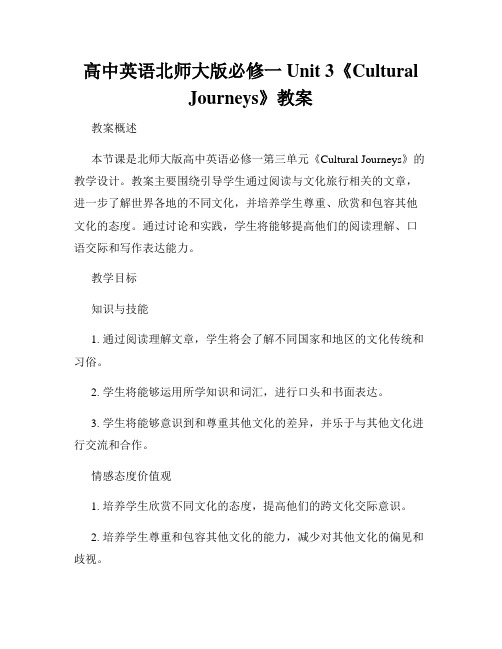
高中英语北师大版必修一 Unit 3《CulturalJourneys》教案教案概述本节课是北师大版高中英语必修一第三单元《Cultural Journeys》的教学设计。
教案主要围绕引导学生通过阅读与文化旅行相关的文章,进一步了解世界各地的不同文化,并培养学生尊重、欣赏和包容其他文化的态度。
通过讨论和实践,学生将能够提高他们的阅读理解、口语交际和写作表达能力。
教学目标知识与技能1. 通过阅读理解文章,学生将会了解不同国家和地区的文化传统和习俗。
2. 学生将能够运用所学知识和词汇,进行口头和书面表达。
3. 学生将能够意识到和尊重其他文化的差异,并乐于与其他文化进行交流和合作。
情感态度价值观1. 培养学生欣赏不同文化的态度,提高他们的跨文化交际意识。
2. 培养学生尊重和包容其他文化的能力,减少对其他文化的偏见和歧视。
教学重点1. 通过阅读文章理解各种不同文化。
2. 提高学生的阅读理解能力和跨文化交际意识。
教学难点1. 培养学生对其他文化的尊重和欣赏态度。
2. 培养学生对其他文化的理解和包容能力。
教学方法1. 合作学习:学生通过小组合作和讨论,共同解决问题并分享彼此的观点。
2. 课堂讲解:教师对重点知识进行讲解和解释,帮助学生更好地理解文章内容。
3. 角色扮演:学生扮演不同的角色,模拟跨文化交流情景,提高他们的口语交际能力。
4. 课外扩展:鼓励学生在课后进行相关题目的整理和扩展阅读,提高他们的自主学习能力。
教学步骤Step 1: 导入新课 (5分钟)1. 向学生介绍本节课的教学目标和内容。
2. 引导学生讨论并分享自己对文化旅行的看法和体验。
3. 引入本节课的主题:“Cultural Journeys”。
Step 2: 阅读理解 (15分钟)1. 学生带着问题阅读文章《Cultural Journeys》,了解不同国家和地区的文化特色。
2. 学生通过小组合作讨论并回答问题,帮助他们理解和消化文章内容。
牛津译林版高一英语必修一教案unit3
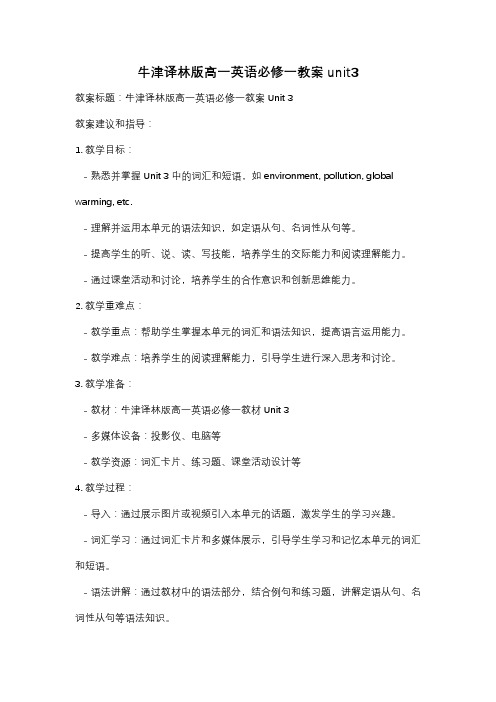
牛津译林版高一英语必修一教案unit3教案标题:牛津译林版高一英语必修一教案Unit 3教案建议和指导:1. 教学目标:- 熟悉并掌握Unit 3中的词汇和短语,如environment, pollution, global warming, etc.- 理解并运用本单元的语法知识,如定语从句、名词性从句等。
- 提高学生的听、说、读、写技能,培养学生的交际能力和阅读理解能力。
- 通过课堂活动和讨论,培养学生的合作意识和创新思维能力。
2. 教学重难点:- 教学重点:帮助学生掌握本单元的词汇和语法知识,提高语言运用能力。
- 教学难点:培养学生的阅读理解能力,引导学生进行深入思考和讨论。
3. 教学准备:- 教材:牛津译林版高一英语必修一教材Unit 3- 多媒体设备:投影仪、电脑等- 教学资源:词汇卡片、练习题、课堂活动设计等4. 教学过程:- 导入:通过展示图片或视频引入本单元的话题,激发学生的学习兴趣。
- 词汇学习:通过词汇卡片和多媒体展示,引导学生学习和记忆本单元的词汇和短语。
- 语法讲解:通过教材中的语法部分,结合例句和练习题,讲解定语从句、名词性从句等语法知识。
- 阅读理解:选择教材中的一篇阅读材料,设计问题和讨论活动,引导学生进行阅读理解和思考。
- 交流活动:设计小组讨论或角色扮演活动,让学生在小组内进行合作交流,分享自己的观点和想法。
- 语言运用:通过练习题和语言游戏,巩固学生对本单元词汇和语法的运用能力。
- 总结归纳:对本节课的重点内容进行总结和归纳,帮助学生理清思路和加深记忆。
- 作业布置:布置相关的作业,如课后练习题、写作任务等,巩固学生的学习成果。
5. 教学评估:- 通过课堂讨论、练习题和作业的批改,对学生的学习情况进行评估和反馈。
- 鼓励学生积极参与课堂活动,提高学生的学习兴趣和主动性。
6. 教学延伸:- 鼓励学生进行相关的课外阅读和研究,拓宽知识面和培养学生的自主学习能力。
英语必修一unit3教案
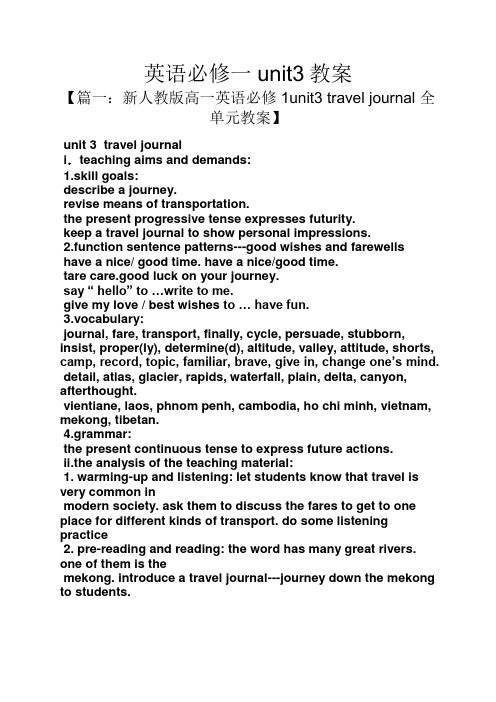
英语必修一unit3教案【篇一:新人教版高一英语必修1unit3 travel journal 全单元教案】unit 3 travel journali.teaching aims and demands:1.skill goals:describe a journey.revise means of transportation.the present progressive tense expresses futurity.keep a travel journal to show personal impressions.2.function sentence patterns---good wishes and farewellshave a nice/ good time. have a nice/good time.tare care.good luck on your journey.say “ hello” to …write to me.give my love / best wishes to … have fun.3.vocabulary:journal, fare, transport, finally, cycle, persuade, stubborn, insist, proper(ly), determine(d), altitude, valley, attitude, shorts, camp, record, topic, familiar, brave, give in, change one’s mind. detail, atlas, glacier, rapids, waterfall, plain, delta, canyon, afterthought.vientiane, laos, phnom penh, cambodia, ho chi minh, vietnam, mekong, tibetan.4.grammar:the present continuous tense to express future actions.ii.the analysis of the teaching material:1. warming-up and listening: let students know that travel is very common inmodern society. ask them to discuss the fares to get to one place for different kinds of transport. do some listening practice2. pre-reading and reading: the word has many great rivers. one of them is themekong. introduce a travel journal---journey down the mekong to students.3.learning about language: in this part, students will discover useful words and expressions and also learn useful structures---- the present continuous tense to express future actionsing language: present how to write a travel journal and then practise writing iii.teaching arrangment1stperiod 2nd period 3rd period 4thperiodwarming-up and listening reading learn about languageusing languagethe first period warming-up and listeningteaching aims1. to talk about things related to travel, e.g. the place the fares and transport, etc.2. to improve the ss’ listening ability.teaching important points1. to talk about travel.2. to tell the ss how to catch the key points when they do listening.emotion goals:there are so many beautiful places in china and the whole world. we should love our country, love the whole world and love nature.teaching aidsa tape recorder, a projector and a computerstep 1. a song (歌词见后面)step 2 warming upshow the photos of some beautiful places on the powerpoint. (the great wall; yuanming yuan ; budala palace; venice; the liberty statue in new york,america; fujiyama.)ask students whether they know where they are.then t ask: do you like traveling? ss: yest: why do you like traveling? (超级链接):enjoy beautiful scenery; increase our knowledge; make friends; be good to health…ss may have a lot of different ideas. give them time to talk freely.t ask: how will you prepare for traveling? (including the time, the place, the means, the cost, the things you’ll take along, … of traveling) (超级链接) :1. time (超级链接):the spring festival; national day; may day; weekend; summer( winter) vacation…2.destination(超级链接): enjoy some beautiful pictures of famous places with the whole class: huangshan黄山; jiuzhaigou九寨沟; guilin桂林; stone forest(石林); jiuquxi(九曲溪; yunufeng,wuyi(武夷玉女峰); sanqing mountain三清山; hangzhou;longmen caves (龙门石窟);tian’anmen square(天安门广场);terracotta,xi’an(西安兵马俑); summer palace(颐和园); london bridge;the opera house悉尼歌剧院; eiffel tower艾菲尔铁塔.3.what to do(超级链接): rock climbing; rafting; bengee; skiing; hikingallow the ss to talk more about it.4.travel cost: talk with the ss quickly.5.things to take(超级链接): id cards(身份证) passports; money (cash); a book of maps; 等。
新人教版高一英语必修一第一册 Unit 3 教案
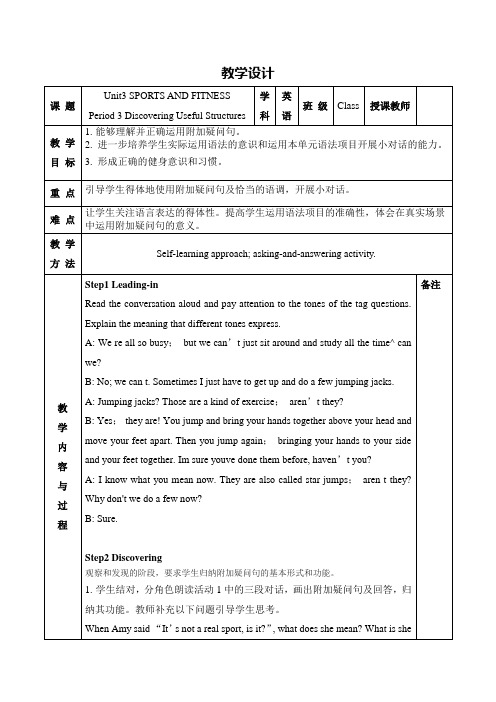
引导学生得体地使用附加疑问句及恰当的语调,开展小对话。
难点
让学生关注语言表达的得体性。提高学生运用语法项目的准确性,体会在真实场景中运用附加疑问句的意义。
教学方法
Self-learning approach; asking-and-answering activity.
教
学
内
容
与
过
程
Step1 Leading-in
When is your birthday?
What do you have for breakfast?
What is your favourite sport?
What sports events have you been to?
Can you ski?
3. Ask students to add a few more questions.
4. As a warm-up activity, have students ask each other the questions in pairs,
swapping pairs a few times.
5. Model the activity with a student first.Tell students not to write down any of the answers, and continue with your class on tag questions.
1. So the other girl won, did she?(根据语境,可以表示兴趣)
2. Oh, you’ve made another mistake, have you?(根据语境,可以表示愤怒)
人教高一英语必修一unit3优秀教案
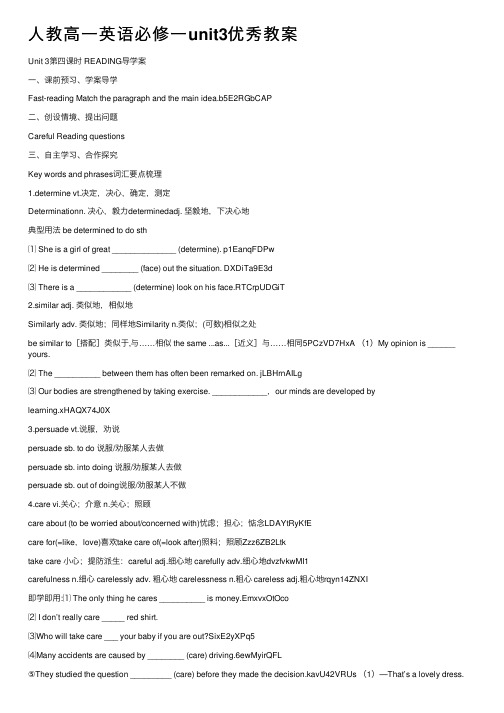
⼈教⾼⼀英语必修⼀unit3优秀教案Unit 3第四课时 READING导学案⼀、课前预习、学案导学Fast-reading Match the paragraph and the main idea.b5E2RGbCAP⼆、创设情境、提出问题Careful Reading questions三、⾃主学习、合作探究Key words and phrases词汇要点梳理1.determine vt.决定,决⼼,确定,测定Determinationn. 决⼼,毅⼒determinedadj. 坚毅地,下决⼼地典型⽤法 be determined to do sth⑴ She is a girl of great ______________ (determine). p1EanqFDPw⑵ He is determined ________ (face) out the situation. DXDiTa9E3d⑶ There is a ____________ (determine) look on his face.RTCrpUDGiT2.similar adj. 类似地,相似地Similarly adv. 类似地;同样地Similarity n.类似;(可数)相似之处be similar to[搭配]类似于,与……相似 the same ...as...[近义]与……相同5PCzVD7HxA (1)My opinion is ______ yours.⑵ The __________ between them has often been remarked on. jLBHrnAILg⑶ Our bodies are strengthened by taking exercise. ____________,our minds are developed bylearning.xHAQX74J0X3.persuade vt.说服,劝说persuade sb. to do 说服/劝服某⼈去做persuade sb. into doing 说服/劝服某⼈去做persuade sb. out of doing说服/劝服某⼈不做4.care vi.关⼼;介意 n.关⼼;照顾care about (to be worried about/concerned with)忧虑;担⼼;惦念LDAYtRyKfEcare for(=like,love)喜欢take care of(=look after)照料;照顾Zzz6ZB2Ltktake care ⼩⼼;提防派⽣:careful adj.细⼼地 carefully adv.细⼼地dvzfvkwMI1carefulness n.细⼼ carelessly adv. 粗⼼地 carelessness n.粗⼼ careless adj.粗⼼地rqyn14ZNXI即学即⽤:⑴ The only thing he cares __________ is money.EmxvxOtOco⑵ I don’t really care _____ red shirt.⑶Who will take care ___ your baby if you are out?SixE2yXPq5⑷Many accidents are caused by ________ (care) driving.6ewMyirQFL⑤They studied the question _________ (care) before they made the decision.kavU42VRUs (1)—That’s a lovely dress.—Do you think so?but I don’t thecolor.A.interested inB.care forC.take care ofD.fond of y6v3ALoS89(2)I don’t think Jack what happensto his family.He is so selfish.M2ub6vSTnPA.cares forB.cares aboutC.cares toD.cares of0YujCfmUCw5.attitude n. 态度;看法attitude to/towards ... 对……地态度翻译:我地英语⽼师改变了对我地态度.My English teacher ________________________ me.eUts8ZQVRd has changed his attitude to/towards me.6.be fond of(=love;like)喜欢;喜爱翻译:虽然她有好多缺点,但是我们都很喜欢她.sQsAEJkW5T She has many shortcomings,but we __________________her.GMsIasNXkA四、师⽣互动、引导点拨1.Ever since middle school, my sister WangWei and I have dreamed about taking a great bike trip.TIrRGchYzg1). dream n. v.dream of/about sth. (vi.)dream that… (vt.)dream sb. to be … (vt.)7EqZcWLZNX2. Then she persuade me to buy one.然后她动员我也买了⼀辆.persuade sb. (not) to do sth.=persuade sb. into / out of doing sth.lzq7IGf02E我已说服他做这件事.e.g. I persuaded him to do it.= persuade him into doing it. zvpgeqJ1hk3. It was my sister who first had the idea to cycle along the entire Mekong River from whereit begins to where it ends. 是我姐姐⾸先想到骑⾃⾏车沿湄公河从它地源头⾏⾛到⼊海⼝.NrpoJac3v1 这是⼀个强调句.强调句地结构是:It was/is+强调成分+that-/who-分句. 如果强调地部分是⼈,可⽤who,也可⽤that, 强调其他成分与内容都⽤that.强调时间和地点不能⽤when或where,只⽤that.1nowfTG4KIe. g.我看这部电影是在上海.(强调地点状语)It was in Shanghai that I saw the film. fjnFLDa5Zoe. g ⑴ All the students held ②a meeting③in the classroom④yesterday.tfnNhnE6e5⑴It was all the students that/who held a meeting in the classroom yesterday. HbmVN777sL(强调主语, was不能换⽤were)②It was a meeting that all the students held in the classroom yesterday. V7l4jRB8Hs(强调宾语 a meeting)③It was in the classroom that all the students held a meeting yesterday. 83lcPA59W9(强调地点状语,that不可换⽤ where)④It was yesterday that all the students held a meeting in the classroom. mZkklkzaaP(强调时间状语that不可换⽤ when)把这个句⼦地不同成分改成强调句.John gave Mary a handbag at Christmas.AVktR43bpw⾼考链接1).Was it ___ that I saw last night at the concert?ORjBnOwcEdA. youB. not youC. that yourself2).It was because of bad weather ___ the football match had to be put off.2MiJTy0dTTA. soB. so thatC. whyD. that gIiSpiue7A3).—Who is making so much noise in the garden?—______ the children.A. It isB. They areC. That isD. There are uEh0U1Yfmh4. Although she didn’t know the best way of getting get to places, she insisted that she organize the trip properly. 尽管她不知道旅⾏地最佳⽅式, 但是她还是坚决主张她来合理安排这次旅⾏.IAg9qLsgBX1) although, though引导让步状语从句不能再和but, and, however连⽤,although从句多放在句⾸, though从句可在主句前,中,后任何位置.WwghWvVhPE[考例] ______ he has limited technical knowledge, the old worker has a lot of experience.asfpsfpi4kA. SinceB. UnlessC. AsD. Although ooeyYZTjj12) insist : 坚持认为,坚持主张※insist on/upon one’s doing sth坚持做,坚决做e.g. I insisted on/upon his coming with us.※insist that +从句“坚持说”(后表⽰⼀个事实), 后接地从句⽤陈述语⽓,既按需要选择时态. e.g. He insisted that he hadn’t stolen the girl’s handbag.BkeGuInkxI ※insist that sb. (should) do sth. 坚决主张做某事,后接地宾语从句常⽤虚拟语⽓, 既“should +v.”e.g. Mary was ill. Her parents insisted that she (should) see a doctor.PgdO0sRlMo⾼考链接1). I insisted that a doctor __ immediately.A has been sent for B. sent forC. will be sent for D. be sent for3cdXwckm152).The doctor insisted that I a high fever and that I a rest for a few days. A.had;hadB.have;haveC.had;haveD.have;had h8c52WOngM3).The man insisted a taxi for me even if/though I told him I lived nearby.v4bdyGiousA.findB.to findC.on findingD.in finding5. My sister doesn’t care about details. 我姐姐是不会考虑细节地.J0bm4qMpJ9care about: be worried about忧虑,关⼼e.g. 他并不关⼼我地事情.He doesn’t care much about what happens to me.care for sb/sth: look after, love or like希望, 喜欢, 照顾XVauA9grYP1) He cares for her deeply.2) Who will care for your child if you are out?6. She gave me a determined look –the kind that she wouldn’t change her mind.bR9C6TJscw 她坚定地看了我⼀眼----这眼神表明她不会改变主意.determine v. 决定, 下定决⼼, 确定 determine to do sth. =make u p one’s mind 下定决⼼pN9LBDdtrd e.g. He determined to learn French. be determined to do sth. 决⼼做DJ8T7nHuGTe.g. She was determined to go to university.change one’s mind 改变某⼈地主意e.g. No matter what you say, I won’t change my mind.QF81D7bvUA7.at an altitude of = at a height of 在海拔……⽶处e.g. The plane is flying at a height / altitude of 10,000 feet.4B7a9QFw9h8. When I told her the air would be hard to breath and it would be very cold…ix6iFA8xoX当我告诉她将呼吸困难, 天⽓严寒……主语 + be + adj.+ to do sth. 是⼀常⽤句式既不定式⽤主动形式表达被动含义e.g. The problem is really hard to work out.My boss is easy to deal with.这类形容词有surprised, moved, disappointed, pleased, happy, sad, delighted, sorry, interested, glad, worried,etc.wt6qbkCyDE9. Finally, I had to give in. 最后, 我只好让步. give in (to sb./sth.) 屈服于, 让步, 递交Kp5zH46zRke.g. He had to give in to my views.\\ It’s time you gave in your papers.Yl4HdOAA61give up 放弃, 认输 ; give out 筋疲⼒尽;分配; ;give away 捐赠, 泄露ch4PJx4BlI练⼀练1) After the long trip, both the men and the horses ________.qd3YfhxCzo2) Because of his small salary, he had to _______ his dream trip to Europe.E836L11DO53) Seeing that he could not persuade me, he had to ___________ my view.S42ehLvE3M4) He _________ most of his fortune to the poor.5) Please keep the secret, don’t ____ it _____.思路点拨:gave out; gave up;gave in to ; gave away ; gave away501nNvZFis※ give in (sth. to sb.)屈服让步上交1) He would rather die than give in.2) Wang Kun had to give in because he knew his sister well.jW1viftGw93) Please give your examination papers in ( to the teacher) when you’ve finished.xS0DOYWHLP 选择题---Smoking is bad for your health ---Yes,I know. But I simply can’t ___.LOZMkIqI0wA. give it upB. give it outC. give it inD. give it away ZKZUQsUJed10. It becomes rapids as it passes through deep valleys, traveling across dGY2mcoKtTwestern Yunnan Province穿过深⾕流经云南省西部时它变成急流.词汇辨析: Across;through ; over prep. 穿过across 常表⽰从⼀定范围地⼀边到另⼀边或事物交叉位置, “横穿, 横跨”表⾯, 含义与on 有关rCYbSWRLIAthrough 表达两边穿过或穿过空间内部, 含义与in 有关over表⽰“越过”是指越过较⾼地物体从⼀侧到另⼀侧e.g. She swam ________the river.The river flows _________the city from west to east. FyXjoFlMWhWalk _______the square and go _________the gate, then you’ll come to the cafe. TuWrUpPObX The thief climbed______the wall and ran away.across ; through ;across ; through ;over实例:The new railway winds its way to Hong Kong, ___ mountains ___ tunnels and ___ rivers.7qWAq9jPqEA.across; over; throughB. over; across; . through llVIWTNQFkC. over; through; acrossD. through; over; across yhUQsDgRT1五、巩固练习、拓展提⾼A.写出下列单词地正确形式:1. He is planning his work _______ (进度表) for the following week.MdUZYnKS8I2. They took many pictures of the _________ (瀑布) yesterday.09T7t6eTno3. What is the ______ (海拔) of this mountain?4. I think you don’t know your own ___________. In fact, no one is perfect.e5TfZQIUB55. He is so s________ that nobody can change his mind.s1SovAcVQM6. Do you know where the s______ of the Changjiang River is?GXRw1kFW5s7.We are looking for someone who is (可靠地) and hard-working.UTREx49Xj98.We tried to p him to give up smoking,but he just wouldn’t listen.8PQN3NDYyP9.Though with great difficulty,I finished all my work f .mLPVzx7ZNw10.Excuse me,what is the f to London?Is $5 enough? AHP35hB02d11.The captain kept a j when he was at sea.He wrote down everything that happened.NDOcB141gT12.Your main d is your lack of job experience.1zOk7Ly2vA点拨:1.Schedule;2.waterfall;3.altitude;4.shortcomings;5.stubborn;6.source;fuNsDv23Kh7.Reliable; 8.persuade; 9.finally; 10.fare ; 11.journal ; 12.disadvantage tqMB9ew4YXB.课⽂原⽂重点句型再现1.Two years ago she bought an expensive mountain bike and then she persuaded me to buy oneHmMJFY05dE2. It was my sister who first had the idea to cycle along the entire Mekong River ViLRaIt6sk from where it begins to where it ends.3. Although she didn’t know the best way of getting to places,she insisted that she 9eK0GsX7H1 organize the trip properly.4.When I told her that our journey would begin at an altitude of more than 5,000 metres,naK8ccr8VIshe seemed to be excited about it.5.It makes wide bends or meanders through low valleys to the plains rice grows.B6JgIVV9aoC.⾼考连接【例1】The CDs are on sale!Buy one and youget completely free. (全国Ⅱ⾼考)P2IpeFpap5 A.other B.others C.one D.ones【例2】—I’ve read another book this week.—Well,maybe is not how much you read but what you read that counts.(浙江⾼考)3YIxKpScDM A.this B.that C.there D.it 【例3】 the police thought he was themost likely one,since they had no exact gUHFg9mdSsproof about it,they could not arrest him. (湖南⾼考)A.AlthoughB.As long asC.If onlyD.As soon as uQHOMTQe79D. 词组识记/英汉互译1. take a great bike trip 11. ⼭地车2. give me a determined look 12. 与…相似IMGWiDkflP3. change one’s mind 13.下决⼼做某事WHF4OmOgAw4. give in /give up5.make up one’s mind 14. 在海拔5000多⽶处aDFdk6hhPd6. have an idea 16. 沿着湄公河从源头骑车⾄终点ozElQQLi4T7. be fond of 17. 梦想做某事CvDtmAfjiA8. as usual 18. 说服某⼈做某事QrDCRkJkxh9. ever since10.care for版权申明本⽂部分内容,包括⽂字、图⽚、以及设计等在⽹上搜集整理.版权为个⼈所有This article includes some parts, including text, pictures, and design.Copyright is personal ownership.4nCKn3dlMX⽤户可将本⽂地内容或服务⽤于个⼈学习、研究或欣赏,以及其他⾮商业性或⾮盈利性⽤途,但同时应遵守著作权法及其他相关法律地规定,不得侵犯本⽹站及相关权利⼈地合法权利.除此以外,将本⽂任何内容或服务⽤于其他⽤途时,须征得本⼈及相关权利⼈地书⾯许可,并⽀付报酬.ijCSTNGm0EUsers may use the contents or services of this article for personal study, research or appreciation, and other non-commercial or non-profit purposes, butat the same time, they shall abide by the provisions of copyright law and otherrelevant laws, and shall not infringe upon the legitimate rights of this website and its relevant obligees. In addition, when a ny content or service of this article is used for other purposes, written permission and remuneration shall be obtained from the person concerned and the relevant obligee.vfB1pxanfk转载或引⽤本⽂内容必须是以新闻性或资料性公共免费信息为使⽤⽬地地合理、善意引⽤,不得对本⽂内容原意进⾏曲解、修改,并⾃负版权等法律责任.JbA9VhEou1 Reproduction or quotation of the content of this article must be reasonableand good-faith citation for the use of news or informative public free information. It shall not misinterpret or modify the original intention of the content of this article, and shall bear legal liability such as copyright.X7Ahr18pJI。
人教版高一必修一unit3 教案

重庆专注教育考试服务中心江北校区:重庆市江北区观音桥步行街嘉年华大厦6-2(苏宁电器右侧)电话:86798788 1Unit3 Travel journal【教学目标】1.了解旅游文化.2.掌握本单元重点词汇和句型。
【教学重点】复习进行时表将来【导入】Do you like travelling? If you have a chance, where do you want to go? Why? (Look at the following pictures, andanswer the question.)安徽黄山重庆金佛山重庆专注教育考试服务中心江北校区:重庆市江北区观音桥步行街嘉年华大厦6-2(苏宁电器右侧)电话:867987882杭州西湖 湖南张家界【短语回顾】1. 梦想做某事 dream of/about doing2. 毕业于(某大学) graduate from…3. 说服某人做.. persuade sb to do sth4. 在午夜at midnight5. 使某人对某事感兴趣 rise one’s interest in sth6. 做某事的最好方式the best way to do sth 7. 坚持做某事 insist on doing sth8. 坚持要某人做某事 insist (that) sb (should) do sth 9. 改变主意 change one’s mind 10. 在…的高度 at an altitude of… 11. 下定决心做某事 _make up one’s mind to do sth 12. 向某人屈服 give in to sb 13. 穿过深 pass through deep valleys14. 像往常一样 as usual15. 鼓励某人做某事 encourage sb to do sth 16. 扎营 make camp17. 搭帐 put up a tent18. 迫不及待做某事can hardly wait to do sth 19. 首先…其次…f or one thing,…..f or another,…. 20. 对熟悉 be familiar with …21. 为某人所熟悉 be familiar to sb22. 创纪录 set a record23. 破纪录 break a record24. 让步,投降give in25. 向某人问候 say “h ello” to sb26. 喜欢 be fond of重庆专注教育考试服务中心江北校区:重庆市江北区观音桥步行街嘉年华大厦6-2(苏宁电器右侧)电话:86798788 3一. 重点词汇讲解1. transport[用法] n.& v.运送;运输[搭配] air transport road transport[拓展] n. transportation运输;交通工具[练习] ⑴那辆黄色公共汽车将会把乘客从机场运送到城里。
英语人教版高中必修一(新课标)教案Unit 3 Listening and Speaking 教案

Unit 3 Sports and FitnessPeriod 1 Listening and Speaking教材分析开篇页选择了年轻人晨跑作为主题图,体现出一种奋进向上以及“生命在于运动”的积极意义,引入运动和健康学习这一单元。
现代奥运之父顾拜旦(Pierre de Coubertin)的名言“All sports for all people.”诠释了人人都有运动的权利。
听说板块围绕“邀请朋友参加体育运动(Invite a friend to a sports event)”,学生通过听两段介绍运动项目的对话,了解体育的趣味性,并通过听和说的形式,结合语境,学习提出邀请和答复邀请的语言功能项目。
语音板块为帮助学生复习并掌握附加疑问句中升调和降调的基本知识。
教学目标1. 能正确理解使用下列词汇:soccer,stadium,boxing,marathon,event,ski。
2. 能在听力活动中抓住内容的主旨大意。
3. 通过阅读开篇页信息,熟悉单元主题语境,预测单元内容,明确学习内容。
4. 能通过运用听力材料中所提取的体育及运动的信息,学会提出邀请和答复邀请。
教学重难点【教学重点】引导学生听取对话的主旨大意,掌握该板块出现的体育运动项目的名称词。
【教学难点】指导学生使用得体的语言邀请别人以及答复邀请。
教学过程Task 1Step 1 Warming-upLook at the opening page and discuss the following questions.(1) Do you jog often?(2) What kind of sports and exercise do you like?(3) What do you think sports and exercise can do for you?(4) Do you know some famous athletes at home and abroad?设计意图:引导学生讨论开篇页所呈现的信息,引出本单元话题,并对本课将要学习的运动与健康做好铺垫。
高一英语必修一教案:Unit3
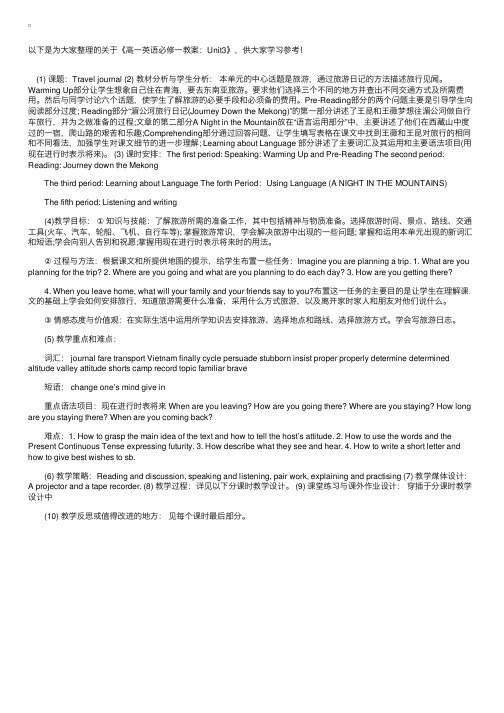
以下是为⼤家整理的关于《⾼⼀英语必修⼀教案:Unit3》,供⼤家学习参考! (1) 课题:Travel journal (2) 教材分析与学⽣分析:本单元的中⼼话题是旅游,通过旅游⽇记的⽅法描述旅⾏见闻。
Warming Up部分让学⽣想象⾃⼰住在青海,要去东南亚旅游。
要求他们选择三个不同的地⽅并查出不同交通⽅式及所需费⽤。
然后与同学讨论六个话题,使学⽣了解旅游的必要⼿段和必须备的费⽤。
Pre-Reading部分的两个问题主要是引导学⽣向阅读部分过度; Reading部分“湄公河旅⾏⽇记(Journey Down the Mekong)”的第⼀部分讲述了王昆和王薇梦想往湄公河做⾃⾏车旅⾏,并为之做准备的过程;⽂章的第⼆部分A Night in the Mountain放在“语⾔运⽤部分”中,主要讲述了他们在西藏⼭中度过的⼀宿,爬⼭路的艰苦和乐趣;Comprehending部分通过回答问题、让学⽣填写表格在课⽂中找到王薇和王昆对旅⾏的相同和不同看法,加强学⽣对课⽂细节的进⼀步理解; Learning about Language 部分讲述了主要词汇及其运⽤和主要语法项⽬(⽤现在进⾏时表⽰将来)。
(3) 课时安排:The first period: Speaking: Warming Up and Pre-Reading The second period: Reading: Journey down the Mekong The third period: Learning about Language The forth Period:Using Language (A NIGHT IN THE MOUNTAINS) The fifth period: Listening and writing (4)教学⽬标:①知识与技能:了解旅游所需的准备⼯作,其中包括精神与物质准备。
选择旅游时间、景点、路线、交通⼯具(⽕车、汽车、轮船、飞机、⾃⾏车等); 掌握旅游常识,学会解决旅游中出现的⼀些问题; 掌握和运⽤本单元出现的新词汇和短语;学会向别⼈告别和祝愿;掌握⽤现在进⾏时表⽰将来时的⽤法。
- 1、下载文档前请自行甄别文档内容的完整性,平台不提供额外的编辑、内容补充、找答案等附加服务。
- 2、"仅部分预览"的文档,不可在线预览部分如存在完整性等问题,可反馈申请退款(可完整预览的文档不适用该条件!)。
- 3、如文档侵犯您的权益,请联系客服反馈,我们会尽快为您处理(人工客服工作时间:9:00-18:30)。
Unit 3 Travel journal---Reading
Teaching goals
1.Knowledge objectives:Learn something about the Mekong River through
reading.
2.Ability objectives:Students can use what they have learned to describe a trip.
3.Moral objectives:Students should realize if they want to be successful, what
personalities they should have.
Teaching important and difficult points:
1.Understand the text well.
2.Try to master the useful new words & expressions in this period.
Teaching method:Task-based teaching, listening, reading, speaking
Teaching aids:a computer & a projector
Teaching procedures
Step 1 warming up
T. Do you like traveling along a river?
T. As we all know, there are a lot of rivers in the world. Now look at the chart.
In the left column are names of some great rivers. In the right column are locations where the rivers lie. Please match them. What role does a river
play in people’s life? In other words, how do people who live along a river use
it?
The suggested answers:
Step 2 Lead In
T. If you plan to travel along a river, what will you do? You may not know what will you do right now, after this class, you will know the answer. Now, let’s learn the reading “Journey down the Mekong”
Step 3 Pre-reading
T:Have you visited the Mekong River? If no, let’s learn something about it. Enjoy a clip of video.
1.Can you list the countries that the Mekong River flows through?
A.China, Myanmarˈmjænmɑː], Laos, Thailand, Cambodia, Vietnam
Step 4 Reading
Task1:Listen to the tape and pay attention to the pronunciation, then do the T or F exercise.
1.Wang kun is a high school student. F college students
2.Both Dao Wei and Yu Hang are grew up in eastern Yunnan province F their college is in Kunming
3.The source of Mekong is in Qinghai province . T
4.Finally Wang Kun agreed with his sister to cycle with her. T
5.They found few atlas and books about Mekong River in library. F a large
7. Only a small part of the river is in China. F half of the river is in china
8.As it enters Southeast Asia, it moves slowly. T
Task2:Scan the text quickly, then answer some questions
1. Who will travel in the text? Wang Kun and Wang Wei and their cousins
2. Where are they going ? Mekong River
3. How are they getting there? They will cycle there.
4.What did Wang Wei prepare for the trip? (BD)
1) Two years ago,she bought an expensive mountain bike
2) Then , she persuaded Wang Kun to buy one
3) Last year,she visited…Dao Wei and Yu Hang and persuade them to join in.
4) Several months before our trip,we went to library to find a large atlas with
good maps
5What didn’t she prepare for the trip?
•(1)。
She didn’t know the best way of getting to the places.
(2).She hadn’t looked at a map to find where we will leave
(3).She doesn’t know when we are coming back.
6. Is it a difficult journey to cycle along the Mekong? Why? Yes. The journey begins at an altitude of more than 5,000 meters, where is hard to breathe and very cold.
7.What can you see when you travel along the Mekong River?
You can see glacier, rapids, hills, valleys, waterfalls and plains.
Task3:Careful reading
1 Read the text again and try to complete a form.
2. The details of the Mekong River give out the outline to help ss to do it( blackboard design)
• 1.It begins at… a glacier on a Tibetan mountain
• 2.As it passes through valleys…it moves quickly
• 3. It enters…the Southeast Asia
• 4.After it leaves…china and high altitude, it becomes wide, brown and warm.
• 5. As it enters.. southeast Asia, its pace slows
• 6. At last it enters …the South China Sea
Task4:Consolidation
Fill in the blanks
Wang Kun and Wang Wei have dreamed about taking a great bike trip. when they _graduated from college. They decided_to cycle_along the Mekong River with。
